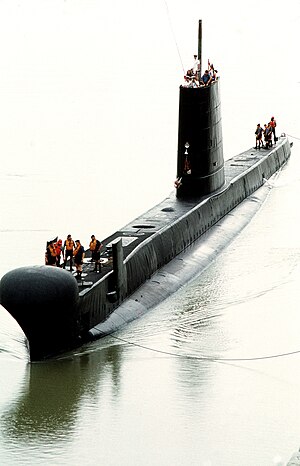HMS Ocelot (S17)
 Ocelot in 1989
| |
| History | |
|---|---|
| Name | Ocelot |
| Builder | Chatham Dockyard |
| Laid down | 17 November 1960 |
| Launched | 5 May 1962 |
| Commissioned | 31 January 1964 |
| Decommissioned | August 1991 |
| Status | Preserved as a museum vessel since 1992 |
| General characteristics as designed | |
| Class and type | Oberon-class submarine |
| Displacement |
|
| Length |
|
| Beam | 26.5 feet (8.1 m) |
| Draught | 18 feet (5.5 m) |
| Propulsion |
|
| Speed |
|
| Complement | 69 |
| Sensors and processing systems |
|
| Armament |
|
HMS Ocelot (S17) is an Oberon-class diesel-electric submarine which was operated by the Royal Navy.
Design and construction
The Oberon class was a direct follow-on of the
pressure hull.[1]
As designed for British service, the Oberon-class submarines were 241 feet (73 m) in length
between perpendiculars and 295.2 feet (90.0 m) in length overall, with a beam of 26.5 feet (8.1 m), and a draught of 18 feet (5.5 m).[2] Displacement was 1,610 tons standard, 2,030 tons full load when surfaced, and 2,410 tons full load when submerged.[2] Propulsion machinery consisted of two Admiralty Standard Range 16 VMS diesel generators, and two 3,000 shaft horsepower (2,200 kW) electric motors, each driving a 7-foot-diameter (2.1 m) three-bladed propeller at up to 400 rpm.[2] Top speed was 17 knots (31 km/h; 20 mph) when submerged, and 12 knots (22 km/h; 14 mph) on the surface.[2] Eight 21-inch-diameter (53 cm) torpedo tubes were fitted (six facing forward, two aft), with a total payload of 24 torpedoes.[2] The boats were fitted with Type 186 and Type 187 sonars, and an I-band surface search radar.[2] The standard complement was 68: 6 officers and 62 sailors.[2]
Ocelot was laid down by
Ojibwa, Onondaga and Okanagan—were built for the Royal Canadian Navy.[citation needed
]
Operational history
After commissioning, Ocelot was assigned to the
Faslane, serving there for three years.[3]
During the 1960s, Ocelot took part in clandestine missions.
Decommissioning and fate
drydock at Chatham Historic Dockyard
HMS Ocelot was paid off in August 1991 as the conventional submarine fleet of the RN began to decline, making way for the nuclear fleet. She was sold in 1992 and preserved as a fully tourable museum in Chatham Historic Dockyard.
In November 2013 the interior of HMS Ocelot was added to Google Street View[6][7] by Google Business Photos[8] Agency, CInsideMedia Ltd.[9]
References
- OCLC 156749009.
- ^ OCLC 18207174.
- ^ "Ships of the Royal Navy: No. 150: Wild Cat Joining Dolphin Squadron". Navy News. May 1968. p. 3. Retrieved 20 August 2018.
- ^ "BBC News - Life on a British Cold War submarine". BBC Online. 12 December 2013. Retrieved 12 December 2013.
- ^ Official Souvenir Programme, 1977. Silver Jubilee Fleet Review, HMSO
- ^ "Google Street View goes INSIDE a Royal Navy submarine". theregister.co.uk. Retrieved 4 November 2013.
- ^ "Google Street View". Google Maps. Retrieved 4 November 2013.
- ^ "Google Business Photos". Google Maps. Retrieved 5 November 2013.
- ^ "Google Street View goes inside British Submarine, HMS Ocelot (S17)". cinsidemedia.com. Archived from the original on 6 November 2013. Retrieved 4 November 2013.
Publications
- ISBN 978-1-86176-281-8.
Gallery
-
Torpedo tubes and escape hatch.
-
The search periscope and the attack periscope.
-
The Diesel Motors charge the batteries so she may travel silently using electric motors.
External links
Wikimedia Commons has media related to HMS Ocelot (S17).
- HMS Ocelot (S17) at Historic Naval Ships Association
- Google Streetview



